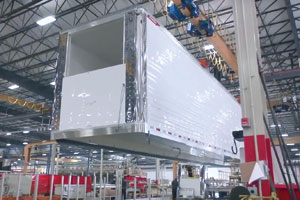Senior Reporter
November Trailer Orders Down 8%; Still Strongest Month of 2016

This story appears in the Jan. 2 print edition of Transport Topics.
U.S. trailer orders in November were more than 36,000 and, while the strongest month of the year, they fell just short of the year-earlier volume, analysts said.
Net orders for new trailers were 36,300, down 8% from 39,192 a year earlier, ACT Research Co. said in a preliminary report, adding that the figure should be within 3% of the final tally.
Much of the strength of the monthly tally came from the U.S. Postal Service, which re-entered the market in a cicada-like fashion and ordered between 7,000 and 8,000 replacement trailers, or about 20% of the total. While the burrowing insects stay underground for 13 or 17 years, the post office typically keeps trailers for 15 years or longer, ACT and others said.
Rival research firm FTR pegged net orders at 35,800.
“When you look at dry vans, it is a huge order month. It is certainly one of the top 10 highest ever,” said Don Ake, FTR’s vice president of commercial vehicles. “It probably stabilizes production through the first half of the year at least in the dry van sector.”
Analysts said it was another strong month for refrigerated trailers, too.
Some of the demand could be from fleets positioning themselves with upgrades ahead of Food Safety Modernization Act requirements that take effect over the next two years, said ACT’s Frank Maly, director of commercial vehicle analysis.
“It could be very expensive for fleets transporting temperature- controlled goods to have something go haywire … if they can’t prove they were able to maintain conditions along the way,” he said.
The rule seeks to minimize the risk of food adulteration through improper refrigeration, inadequate cleaning of vehicles between loads and the failure to otherwise properly protect food during transportation.
Maly also said the ratio of trailers to tractors is rising.
It has been more than 2.5-to-1 for most of 2016, but in November topped 3-to-1, reflecting seasonality, he said. That compares with 1.7-to-1 in 2015.
“There’s more emphasis on drop-and-hook just to wring as much productivity out of the system as [fleets] can,” Maly said.
Trailer makers said the order volume did not catch them by surprise and, in part, linked the bounce to the conclusion of the presidential election.
“Fleets had expressed their intention to purchase trailers in 2017 but were delaying the decision to better gauge where the economy was going,” said Glenn Harney, chief sales officer of Hyundai Translead.
“Now we need to see if November was the exception, or if we can expect a couple of good months to solidify the backlog for the first half of 2017. I think there is some strength left to build on,” he said.
Typically, fleets work on truck orders then place trailer orders, said David Gilliland, vice president of national accounts for Great Dane Trailers.
“So, we just had to be patient. We also expect fairly robust demand now that the election is over,” Gilliland said.
Charles Willmott, chief sales officer at Strick Group, agreed.
“Many carriers delayed capital budgets until after the election, but since then it has been hard to keep up with new orders,” he said.
While orders are flowing in to make a healthy first and second quarter in 2017, there is now too much manufacturing capacity, due to expansions, possibly by as much as 48,000 units a year industrywide, said David Giesen, vice president of sales at Stoughton Trailers.
“This will need to adjust down with real demand for 2017,” he said.
One of Stoughton’s largest customers had yet to place its main order, he said Dec. 22. “If they wait until after Christmas, it’s a January number. and that one is in the thousands.”
Giesen confirmed the Postal Service order and called it “a one-time deal.” Trailer makers will build these units and “it is leasing companies that end up buying them,” he said.
Meanwhile, next year’s trailer market could either be softer or flat, compared with 2016, as analysts’ opinions differed somewhat.
ACT forecasts 2017 will be softer than 2016 for trailer orders, said Maly. “We are not talking a huge down cycle but lower next year.”
He said lower industry volumes matched with higher available capacity is “not a good mix. … it’s not the most opportune timing for that.”
The backlog of unbuilt orders in November was up 15% from October, but remains down almost 40% from the same point a year ago, he said.
At the same time, orders are not following a typical pattern, Ake said. “Although what we can say is orders over the last 12 months were 210,000, and my forecast for next year is for over 240,000.”




